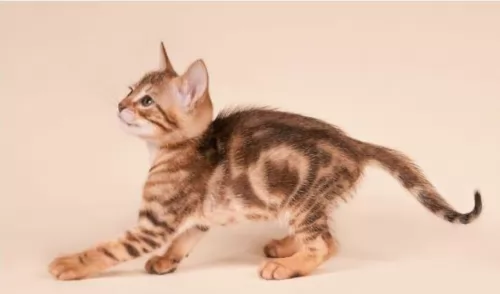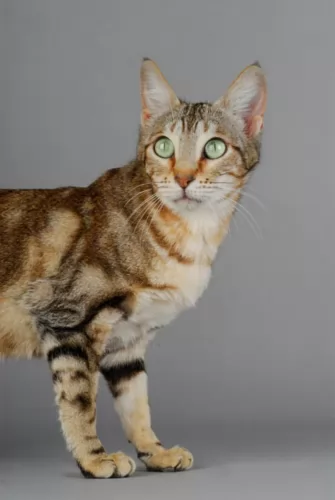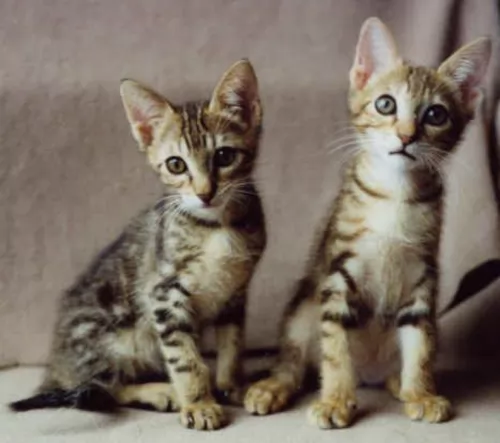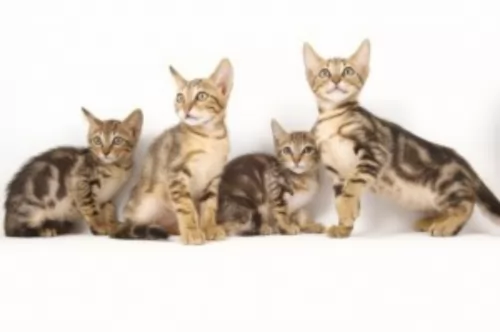 Petzlover
PetzloverSokoke is originated from United States but Sumxu is originated from China. Both Sokoke and Sumxu are having almost same weight. Both Sokoke and Sumxu has almost same life span. Both Sokoke and Sumxu has same litter size. Both Sokoke and Sumxu requires Low Maintenance.
 Compared to other breeds of cat, the rare Sokoke Forest Cat is a fairly new natural breed. It comes from the Sokoke district of eastern Kenya but was developed in the USA.
Compared to other breeds of cat, the rare Sokoke Forest Cat is a fairly new natural breed. It comes from the Sokoke district of eastern Kenya but was developed in the USA.
It is in fact, named after the Arabuko Sokoke National Forest, from where the wild foundation stock came from. Wildlife artist Jeni Slater started breeding these cats in the 1970s. They eventually reached Denmark, where further breeding continued, with the cat becoming popular with local cat fanciers, and laid the foundation of the breed in Europe.
Today, there are just a few breeders registered in the UK and TICA, The International Cat Association lists the Sokoke cat as a New Preliminary Race and it was recognized by FIFe in 1993.
The Sumxu is an odd-looking cat with its droopy ears or drop-ears. The truth is, the cat is considered extinct and the last reported Chinese lop-eared cat was way back in 1938.
According to reports, the cat seems to have first made an appearance in 1656 and was always described as a curiosity. It seems as if they were valued as pets but they were also used as food. A Polish man was the first Westerner to describe the Sumxu in his illustrated book Flora Sinensis. The breed was once found in and around Peking and resembled a long-haired Scottish Fold.
 The Sokoke is a medium-sized cat with a long, lean body and slender legs. The hind legs are somewhat longer than the front legs. The head is smallish and round and he has a constantly alert look to him.
The Sokoke is a medium-sized cat with a long, lean body and slender legs. The hind legs are somewhat longer than the front legs. The head is smallish and round and he has a constantly alert look to him.
A striking characteristic of the Sokoke cat is its tabby fur, which people say looks like the bark of a tree and it is brindle in coloring.
The tail is medium to long and the ears are also fairly large, The eyes are large and almond-shaped and can be greenish to brown. The coat is short and coarse.
Cat lovers enjoy these playful, curious, intelligent, and family-orientated cats. In spite of their wild side, they adapt easily into different homes.
They’re inquisitive and will follow you, much like a dog. They will even enjoy a leash being put on them and being taken for a walk. They’re very sociable and vocal too and get on with everyone, children and other pets included.
They’re playful cats, loving to jump and climb and then look down at you from their high perches. Easily bored, you will need to provide fun and games continuously.
They enjoy being involved with everything you’re doing and form a strong bond with their owners. Because the Sokoke is social and affectionate, they require quite a lot of attention, and if they don’t get the attention they crave, they meow in anxiety.
The Chinese have always eaten this cat and because it has always been found in restrictive conditions the cat lost its keen sense of hearing because it no longer needed to hunt. The cat's ears lost their upright nature and became the hanging ears that are characteristic of the Chinese cat.
The cat had a long silky, shiny coat and was a dirty yellowy type of color. It had a ruff, a thick tail and blue, slanted eyes. It is thought that the size of the Sumxu was somewhat larger than the standard cat so he would have been a medium to large-sized cat, weighing in the region of 4 to 7kg. He was thick-set and muscular.
It is thought that this cat wasn’t particularly active and that it seems to only become really animated when offered food, preferring to lie beside a warm fire than to be found outside. We can only assume that it was a fairly quiet cat.
 Your Sokoke is a very social cat and he will get on particularly well in a home with children who have been taught to be kind and gentle with animals.
Your Sokoke is a very social cat and he will get on particularly well in a home with children who have been taught to be kind and gentle with animals.
They are able to adapt well to homes where there are other pets too. They just love exercise and lots of fun. They don’t like being in a home where the owner is out at work all day. The solution to this is to provide him with another cat as a companion.
Sokoke cats are great with people of all ages, and when you bring one of these lively cats into your home, make sure he also receives his share of love and companionship.
Not much is known of the character of the Sumxu cat as it is now extinct. It doesn't matter what kind of cat you have because every cat needs to be loved and well cared for. If you can't do that, then why get a cat in the first place.
 Sokoke cats are generally healthy and have no inherited diseases. To ensure that your Sokoke stands a chance of having a healthy life, you need to have him vaccinated against the life-threatening cat diseases there are.
Sokoke cats are generally healthy and have no inherited diseases. To ensure that your Sokoke stands a chance of having a healthy life, you need to have him vaccinated against the life-threatening cat diseases there are.
If your Sokoe cat isn’t his usual self day after day, make a point of getting him to the vet just as soon as possible.
Parasites are a terrible scourge with cats, and in fact, the number one cause of hair loss in cats is fleas. The bite of a flea can cause an allergic reaction. Your cat can become miserable with continuous biting, itching, and scratching and this can all lead to hair loss.
It is a wise move to speak to your vet about a good product to treat your furry friend with.
There can actually be many causes of diarrhea in cats and one of them is parasites, but it can also be caused by a viral infection or food allergy or something else.
You want to get your cat to the vet who can help you bring it under control. You may also have to feed your cat a bland kind of diet to help the cat’s digestive tract recover from the diarrhea.
The Sumxu cat should have seen the veterinarian every year for an examination and to make sure his vaccinations and deworming were up to date.
It is never a good idea to give your cat medication that hasn't been prescribed by the vet. If the Sumxu cat had ingested a poisonous substance, it would have been kind to call the vet. It would have been dangerous for the Chinese to eat such a cat that had ingested poison.
While cats should be spayed and neutered, it is quite possible that the Sumxu cat was eaten before it ever had a chance to become a parent. Neutering and spaying a cat has health benefits for the cat and can prevent cancers.
 Because the Sokoke’s coat is short and close-lying, with little or no undercoat, brushing once a week will be sufficient.
Because the Sokoke’s coat is short and close-lying, with little or no undercoat, brushing once a week will be sufficient.
The Sokoke cat is very energetic, and he will need games, toys, and attention to keep him physically and mentally stimulated. They love climbing so a climbing tree and other kind of equipment will be a good idea.
Provide your cat with a litter box and ensure it is kept scrupulously clean by removing the cat’s feces every single day.
Diet is of critical importance to the health and happiness of a cat. Some people try to feed their cats human foods and wonder why their cat is continuously sick. A cat is a carnivore and he requires meat.
You can speak to your vet about the best kind of commercial cat food there is for your cat. Read the label and feed him portion-sizes as directed.
One would have hoped that the now-extinct Sumxu cat received high-quality cat food. If you don't know what to feed your cat, your veterinarian will be able to advise you on the best diet. The cat food manufacturers always produce foods that take into account the cat's age and activity levels.
Certainly, every cat needs taurine, an essential amino acid, for heart and eye health. The food you choose for your cat should contain all the necessary vitamins and minerals.
You will need to provide fresh, cool water for your cat at all times. Wash and refill your cat’s water bowls regularly.
Take your pet to your vet for any signs of illness such as diarrhea, vomiting or lethargy.
The Sumxu cat would have required a brush every few days as the coat was long and silky. Brushing helps keep your cat's coat free of dust and loose hairs.
Your cat will need a litter box which should be placed in a quiet, accessible location. The Sumxu cat would not have liked feces in his litter box, and litter boxes of all cats should be kept clean.